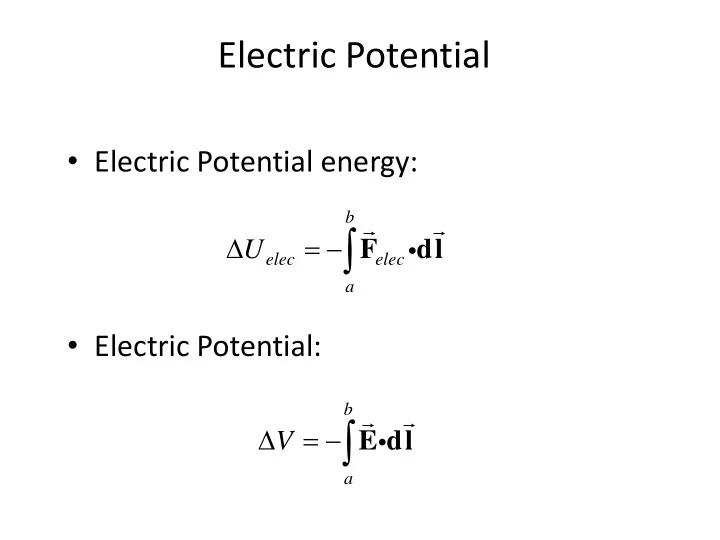

Electric Potential • Electric Potential energy: b F U dl elec elec a • Electric Potential: b E dl V a
Field is the (negative of) the Gradient of Potential dU dV F E x x dx dx dU dV F U F E V E y y dy dy dU dV F E z z dz dz
In what direction can you move relative to an electric field so that the electric potential does not change? 1)parallel to the electric field 2)perpendicular to the electric field 3)Some other direction. 4)The answer depends on the symmetry of the situation.
Electric field of single point charge kq 2 ˆ E = r r
Electric potential of single point charge b V E dl a kq ˆ E r 2 r b kq ˆ V r dl 2 r a
Electric potential of single point charge b V E dl a kq ˆ E r 2 r b kq ˆ V r dl 2 r a kq kq V V V b a r r b a kq V const . r 0 by convention
Potential for Multiple Charges E E E E 1 2 3 b V E dl a b b b E dl E dl E dl 1 2 3 a a a V V V V 1 2 3
Charges Q and q ( Q ≠ q ), separated by a distance d , produce a potential V P = 0 at point P. This means that 1) no force is acting on a test charge placed at point P. 2) Q and q must have the same sign. 3) the electric field must be zero at point P. 4) the net work in bringing Q to distance d from q is zero. 5) the net work needed to bring a charge from infinity to point P is zero.
Finding the Electric Field due to Continuous Charge Distributions • When possible, use symmetry to eliminate one or more component of the electric field. • Define a (linear, areal or volume) density to relate small spatial regions to small bits of charge. • Calculate the electric field due to each small k dq charge bit: . dE 2 r • Sum up (integrate) the electric fields to find the total field.
Finding the Potential due to Continuous Charge Distributions • When possible, use symmetry to eliminate one or more component of the electric field. • Define a (linear, areal or volume) density to relate small spatial regions to small bits of charge. • Calculate the potential due to each small k dq charge bit: . dV r • Sum up (integrate) the potentials to find the total potential.
Spherical shell of charge kQ 2 ˆ E r r R out r E 0 r R in kQ V r R out r kQ V a constant in R r R
Recommend
More recommend